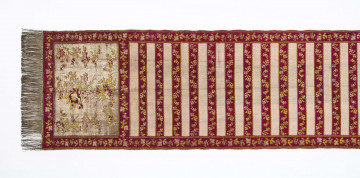
One-sided kontusz belt
1766 — 1788
National Museum in Lublin
Part of the collection: Textiles, embroideries, clothing and costume accessories of the 16th–19th c.
The robe belt (kontusz belt) comes from the factory in Kobyłka. In the 18th century, the craft of weaving, and especially creating elaborate and good-quality robe belts, was highly valued. The trader and weaver Szczepan Filsjean probably came from Lyon and settled in Poland around 1774. In 1778, thanks to starost Aleksander Unrog, a factory for these sought-after elements of Sarmatian costume, known as a sash manufactory, was set up in Kobyłka near Warsaw, and Filsjean made his fortune there. His contemporary Hubert Vautrin wrote about meeting his compatriot: '[...] one craftsman from Lyon, who settled near Warsaw, and whose wares were superior to Persian and Turkish. He made such a variety that one might present eight combinations of colours and drawing'. Initially, Filsjean was a member of the so-called Company, which used the Unrog factory in Kobyłka. He then became a tenant of that factory, and around 1787, its owner. Polish customers sought after his belts, distinguished by their originality and richness of colours. The products not only presented a good quality of silk fabric, often interwoven with silver or gold thread, but were also characterised by a variety of patterns and colours. He probably designed his belts himself, drawing inspiration from Western European, French and Eastern Persian patterns. Belts from Filsjean's sash manufactory with an original parrot motif were recorded in the royal collection. King Stanisław August Poniatowski, although he did not wear a robe, appreciated the original ornamentation and good quality Polish belts. On the wave of patriotic mood during the Four-Year Sejm, Filsjean enriched the royal wardrobe with belts embossed with the coats of arms of Poland and Lithuania. The entrepreneur's merits for developing the weaving craft were appreciated in 1790, and he received the nobility by the Sejm's decision. The factory in Kobyłka operated successfully until its owner's tragic death. In Warsaw, in 1794, he was killed by a Russian Cossack in a street fight during the Kościuszko Uprising. Today, Szczepan Filsjean's robe belts are a reminder of traditional Polish costume, and at the same time, a symbol of the turbulent and tragic fate of the Polish Republic during the Enlightenment.
Magdalena Norkowska
Author / creator
Dimensions
cały obiekt: height: 376 cm, width: 39,4 cm
Object type
a contoured belt
Technique
weaving
Material
silk (natural fabric)
Creation time / dating
Creation / finding place
Owner
The National Museum in Lublin
Identification number
Location / status

1766 — 1788
National Museum in Lublin

1789 — 1793
National Museum in Lublin

1767 — 1780
National Museum in Lublin
DISCOVER this TOPIC
National Museum in Lublin
DISCOVER this PATH
Educational path